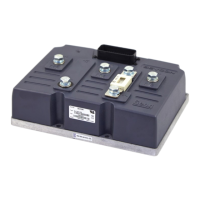Some vehicles can exhibit shock due to the rapid reversal of torque after a direction change.
2909
h
can be set to force the vehicle to remain stationary for a period before driving in the new
direction.
To prevent early exit from neutral braking, a debounce timer can be set at 290D
h
. Neutral
braking only finishes when the vehicle has been stopped for longer than this time. This can help
prevent early exit of neutral braking due to motor oscillation caused by under damped
suspension.
On vehicles with gearbox meshing issues, a slower rate of torque ramp up at low speeds can be
configured at 291C
h
. This slow rate of change of torque lessens shock due to gear meshing.
Used in torque mode only.
Brake feathering reduces neutral and foot braking torques as the vehicle speed approaches 0 to
prevent any roll-back in the opposite direction. This is set at 290E
h
. Use 290E
h
,1+2 to set start
and end speeds for feathering, 290E
h
, 3 to configure the final torque at the end of braking and
290E
h
, 4+5 to configure entry and exit ramp rates for feathering torque to prevent disturbance in
torque when changing between drive and braking conditions. Used in torque mode only.
Footbrake
The controller can use a switch or analogue voltage as the footbrake input. If a footbrake switch
is mapped, it applies maximum foot braking when the switch is closed. The footbrake switch
object (2130
h
) must be mapped to a digital input.
If the footbrake input is an analogue voltage, configure the voltage levels in the same way as the
throttle. The footbrake voltage (2221
h
) must be mapped to an analogue input.
Configure the characteristics of the footbrake at 2911
h
:
Drive/foot braking priority. If the throttle and footbrake are pressed at the same time, this
setting determines whether the system attempts to drive or brake.
Minimum speed for braking. Foot braking stops when the vehicle speed drops below this
level.
Footbrake voltage input and Input characteristic. These settings are similar to those for the
throttle. Refer to the Throttle section above for more information.
Footbrake priority timeout allows the configured priority to change after a timeout period.
Setting zero will disable this feature.
The footbrake value calculated from the voltage can be read at 2621
h
.
Steering inputs – twin driving motor systems
CAUTION: Loss of steering information can make a vehicle operate erratically. The analogue
input use for the steering sensor should have suitable wire-off protection configured.
Twin motor systems, which use the drive motors for turning, require some means of determining
the angle of the steering wheel.
To do this use one of these options:
A steering potentiometer to give an analogue voltage which is a linear function of the
steering angle. The steer potentiometer voltage (2223
h
) must be mapped to an analogue
input.
Four digital inputs representing ‘inner left’, ‘inner right’, ‘outer left’ and ‘outer right’. The inner
switches indicate the steering angle where torque to the inner wheel motor is removed. The
outer switches indicate the steering angle where inner wheel motor changes direction. The

